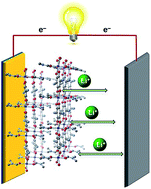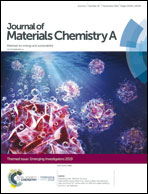Elucidating metal and ligand redox activities of a copper-benzoquinoid coordination polymer as the cathode for lithium-ion batteries†
Abstract
A novel redox-active quinone-based organic building block 1,4-dicyano-2,3,5,6-tetrahydroxybenzene (LH4) has been synthesized and used as a bridging ligand to form a new 1D copper-benzoquinoid coordination polymer [CuL(DMF)2]n. The compound is able to deliver an initial capacity as high as 268 mA h g−1 at 30 mA g−1 (∼C/2.5) when used as the cathode in Li batteries. Ex situ XPS and FT-IR reveal the involvement of both Cu and organic moieties in the multi-electron redox reaction. Cu K-edge XANES and EXAFS measurements confirm the change in the oxidation state and coordination environment of Cu during the discharge–charge process. In situ generated metallic nanoparticles have been observed by TEM. The obtained mechanistic understanding of the metal–organic electrode materials for Li-based batteries may pave the way for the design of next-generation energy-storage systems.

- This article is part of the themed collection: Journal of Materials Chemistry A Emerging Investigators


 Please wait while we load your content...
Please wait while we load your content...
